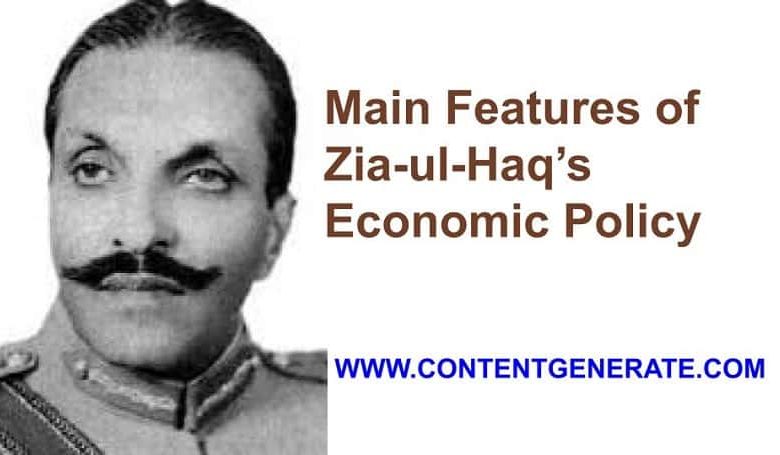Economic Policy of Zia-ul-Haq – Main features

This post discusses Zia-ul-Haq’s economic policy that he adopted during his rule in Pakistan from 1977 to 1988.
Contents
What were the main features of Zia-ul-Haq’s Economic Policy?
The salient features of Zia-ul-Haq’s economic policy were as follows:
1. Privatization
General Zia ul Haq reversed the nationalization process undertaken by Zulfiqar Ali Bhutto. He returned the nationalized institutions i.e. industries, banks, schools, etc. companies to their former owners. Moreover, he introduced laws banning nationalization in the future.
The military regime provided fiscal and non-fiscal incentives to encourage private companies to invest in the country. Moreover, he drew a clear line between the public and private sectors and provided tax concessions.
The incentives and the constitutional guarantees provided against future nationalization by the military regime led to the improvement in the overall investment climate.
2. Liberalization
The term liberalization refers to the loosening of government controls. In particular, it refers to reductions in restrictions on international trade and the flow of capital across the state borders.
Measures that were taken by Zia as part of his liberalization program
Unlike Bhutto, Zia-ul-Haq switched over to the liberalization of the economy. That is he adopted a market-based development strategy in all departments of national life.
The military regime of Zia-ul-Haq:
- concluded a three years extended fund facility (EFF) with the IMF in 1980.
- undertook several structural reforms aiming at financial deregulation and greater economic liberalization
3. Establishment of industrial zones
Zia established industrial zones intending to create attraction for foreign investment and in-flow of modern-day technology from the developed world. Moreover, the industrial zones helped create increased employment opportunities and enhance management skills. They were also aimed at encouraging the manufacturers and providing them with an environment free from taxes i.e. export and import duties.
The establishment of industrial zones did not turn out to be advantageous as the output was not encouraging. Contrary to the expectations, the goods exported from the zone were relatively small scale.
4. Islamization of the economy (Zakat and Ushr Tax)
Zia-ul-Haq attempted to set the economic system of Pakistan on the economic model of Islam. Zia promulgated the two most important ordinances in this regard were the Zakat Ordinance and the Usher Ordinance in June 1980.
According to the ordinance, the government deducted 2.5% of the balance from the bank accounts annually. In every village and town, Zia set up Zakat Committees consisting of his loyalists to distribute the collected amount among the poor and needy.
Similarly, the Usher was an agricultural tax imposed on farmers. They were liable to pay 5 % of their agricultural productivity as part of Ushr Tax.
What was the impact of Zia-ul-Haq’s Economic Policy on Pakistan?
According to the political economists, the Zia-ul-Haq period saw relatively a high and sustained rate of The economy under Zia enjoyed a high and economic sustained growth rate. For instance, the average economic growth rate increased to 6.6 % per year whereas the inflation rate kept reducing during 1977 and 1978.
As a result of this rise in economic growth, the country saw a broad sharing of the economic benefits at different levels. For example, the Zia period witnessed an increase in real wages leading towards poverty reduction.



